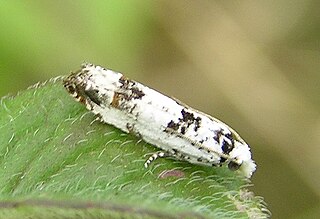
Eucosma is a very large genus of moths belonging to the family Tortricidae. Some taxonomies place a number of species in the genus Eucopina. The genus has a Holarctic and Indomalayan distribution. Even in well-studied Europe and North America, new species are still regularly discovered. There are at least 670 described species in Eucosma worldwide.

Eucosma campoliliana is a moth of the family Tortricidae. It is found in Europe, China, Japan and Russia.
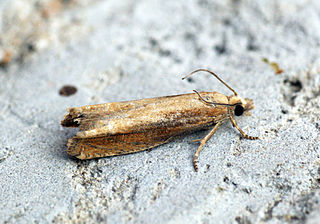
Eucosma obumbratana is a moth of the family Tortricidae. It is found in Europe, China (Jilin), Russia and Kazakhstan.

The Eucosmini are a tribe of tortrix moths.

Aethes smeathmanniana, or Smeathmann's aethes moth, is a moth of the family Tortricidae. It was described by Johan Christian Fabricius in 1781. It is found in most of Europe, Asia Minor and in North America, where it has been recorded from New Jersey and Newfoundland and Labrador.

Clepsis pallidana is a moth of the family Tortricidae. It is found in most of Europe, as well as Asia Minor, Iran, Russia, Mongolia, China, the Korean Peninsula and Japan.

Eucosma metzneriana, the mugwort bell, is a species of moth of the family Tortricidae. It is found on Sicily and in Great Britain, the Netherlands, Belgium, Luxembourg, France, Germany, Denmark, Austria, Switzerland, Italy, the Czech Republic, Slovakia, Slovenia, Hungary, Bulgaria, Romania, Poland, Sweden, Finland, the Baltic region, Ukraine, Russia, North Africa, Transcaucasia, Asia Minor, Iran, Kazakhstan, Kyrgyzstan, Mongolia, China, Korea and Japan.
Eucosma ephedrana is a species of moth of the family Tortricidae. It is found in Transcaucasia, Central Asia, Iran and Afghanistan.

Eucosma pupillana is a species of moth of the family Tortricidae.
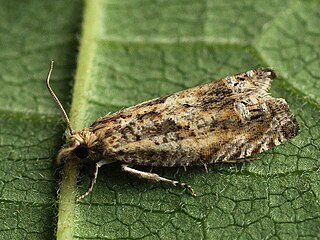
Eucosma aemulana, the obscure bell, is a species of moth of the family Tortricidae. It is found in China, Korea, Russia and most of Europe. It is also found in the United States, where it has been recorded from Colorado, New Mexico, Oklahoma and Utah. The habitat consists of woodlands, chalk downland and cliffs.

Eucosma aspidiscana, the golden-rod bell, is a species of moth of the family Tortricidae. It is found in China, Mongolia, Korea, Japan, Russia, North Africa and most of Europe. The habitat consists of woodlands, downland, waste grounds and cliffs.

Eucosma cana, the hoary bell, is a species of moth of the family Tortricidae.
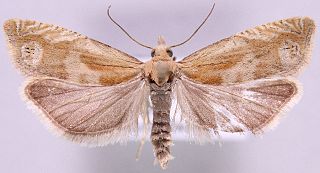
Eucosma hohenwartiana, the bright bell, is a species of moth of the family Tortricidae. It is found in China, Central Asia, North Africa and Europe, where it has been recorded from Sardinia, Sicily, Ireland, Great Britain, Spain, France, Germany, the Benelux, Denmark, Austria, Switzerland, Italy, the Czech Republic, Slovakia, Slovenia, Hungary, Poland, Romania, Bosnia and Herzegovina, Norway, Sweden, Finland, the Baltic region and Russia. The habitat consists of dry open areas and grassland.

Eucosma messingiana is a species of moth of the family Tortricidae. It is found in China, Mongolia, Russia and Europe, where it has been recorded from Germany, the Czech Republic, Denmark, Hungary, Poland, the Baltic region, Sweden and Finland. The habitat consists of sandy areas.
Eucosma niveicaput is a species of moth of the family Tortricidae. It is found in China, Japan and the Russian Far East.
Eucosma ommatoptera is a species of moth of the family Tortricidae. It is found in Japan, China and the Russian Far East.
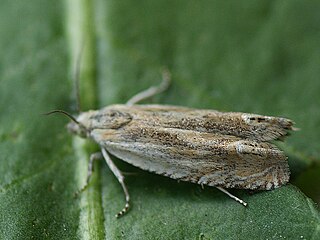
Eucosma wimmerana is a species of moth of the family Tortricidae. It is found in China, Mongolia, Japan, Russia, Kazakhstan and Europe, where it has been recorded from Sicily, France, the Netherlands, Germany, Austria, Switzerland, Italy, the Czech Republic, Slovakia, Poland, the Baltic region, Slovenia and Romania.
Eucosma striatiradix is a species of moth of the family Tortricidae. It is found in China (Jilin), Korea, Japan and Russia.

Eucosma dorsisignatana, the triangle-backed eucosma, is a species of moth of the family Tortricidae. It is found in North America, where it has been recorded from Nova Scotia to Florida, west to Texas and north to Manitoba.
Eucosma hennei, or Henne's eucosman moth, is a species of moth of the family Tortricidae. Specimens have been recovered in the El Segundo sand dunes in California The habitat includes open sand, undisturbed sand dunes and dense shrubs populated with the larval host plant Phacelia.















